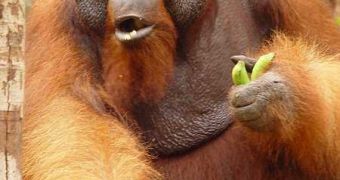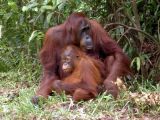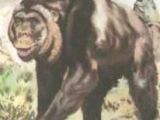1. The Orangutan is the only Asian ape, closely related to humans, chimps and gorillas, from which they split more than 8 million years ago. Today they live in the islands of Borneo and Sumatra (southeastern Asia). Till recently, they were believed to represent the same species, but DNA analysis showed there are two species: Borneo orangutan (Pongo pygmaeus) (12,500 to 20,500 individuals) and Sumatra orangutan (Pongo abelli) from northern Sumatra (around 5,000 individuals).
The Sumatra orangutan is slender, lighter colored (the Borneo orangutan is chocolate brown) has longer hair and face; males of this species have longer, yellow or white beards. Orangutans' raveled hair varies in color from orange to brown.
There are two types of Sumatra orangutan: one brownish to black (skin and hair), delicate limbs and nailed on the first finger, and a reddish type, more massive, with larger limbs and a nailless first finger. This species has a more organized social and tree-linked life due to the presence of the tiger in that island, which misses in Borneo.
2. Males are twice bigger than females and they look even larger due to their facial disk (made of fatty tissue) and the double chin that amplifies their calls. Mature males have darker hair than females and young males.
The male orangutan is a huge beast: 1.5 m (5 ft) tall (but the body is very large compared to human's and the feet very short), 90-100 kg (220-240 pounds) heavy with an arm span of 2.4 m (8 ft). Females are 1.15 m (4 ft) tall and 40-50 kg (100-120 pounds) heavy.
Orangutans live 35-40 years in nature and up to 60 years in captivity.
3. Because orangutans are heavy, their movements through trees are slow and not very graceful. The feet acts like hands, and the powerful toes act like hooks.
4. Orangutans are solitary beings; only mother and offspring have a stable bond. Dominant males are territorial, but they do not mark their territory, and territories can partially overlap. A male's territory can be of 1-5 square km (0.4-2 square mi) and harbors females, offspring and subordinate males.
If two dominant males meet, they prefer to fake they do not see each other, but sometimes male fight violently and noisy, and the result can be in many cases the death of one of them, due to the wounds provoked by the huge canines.
Dominant males signal their presence (for chasing away intruders or luring females) through prolonged (1-3 minutes) and powerful roars. Before roaring, they brake branches which they toss to the ground, like in chimps. The roar starts with a low tonality, like a deaf pig grunt, increases gradually till turning into a long howl (similar to the lion's) which calms down into low sounds. The facial disk reflects and heads the emitted sounds.
Still, immature orangutans (especially males) form social groups of 2-3 individuals.
5. Orangutans are considered the largest arboreal animal. They build for the night nests on the trees, located at about 20 m (66 ft) from the soil, made from bended and woven branches. Sometimes they cover for sleeping with branches. Aging males spend more time on the ground because their increasing weight makes movement in the trees more difficult.
6. Orangutans eat mainly fruits, but also seeds, leaves, buds, bark, insects (termites, ants), bird eggs and even small mammals. The powerful jaws allow them to break fruits with extremely tough husks and their high intelligence allows them to make a mental map of the forest, knowing always where to find ripe fruits in their territory, in which they move 300-1000 m (0.2-0.6 mi) per day.
Orangutans are known to ingest soil for completing their mineral requirements. Because males are heavier, females and males feed on different levels on the same tree (females up, males down), not competing with each other. Orangutans may descend from time to time to drink water gathered at the base of the tree.
Males spend more time on the ground also because they feel safer against predators (tiger, clouded leopard, man). Only the tiger can kill adults, while the clouded leopard can kill just young orangutans.
7. Inside the territory of a dominant male, there are more resident females. When one female is sexually receptive (fertile), the male will follow her and mate with her regularly, for several weeks. Orangutans mate in the trees face to face! When the female gets pregnant, they split, and the male will look for other receptive female.
The gestation period is 9 months (sounds familiar?) and the offspring, having about 1.5 kg (3 pounds) at birth, is breastfed for 4 years, and their bond breaks when the female gives birth to another offspring (usually, the young is now 7-8 years old). The young can move in the trees by itself at the age of 3.5 years. Females give birth to one young at each six years till they are 30 years old (thus, they produce 3-4 young in a lifetime). Orangutans are sexually mature at the age of 7-10, but the presence of a dominant male can inhibit the male's development, remaining subadults for another up to 15 years.
Males are sterile by 30 years; after this age, the dominant males allow the subadult males to mate with the females. Subadult males are known to rape females anyway.
When the dominant male dies, his successor experiences sudden changes: it a few moths grows from 45 kg (110 pounds) to 100 kg (240 pounds), appears the facial disk and it turns extremely aggressive; he can now emit the typical roar of the dominant males.
8. Orangutans wake up at 6:30 in the morning and get to bed (nest) at 18:00. They spend 46 % of their awake time feeding, 39 % resting and 11 % moving.
9. Two million years ago, a larger species of orangutan lived in northern Indochina, while in the island of Java lived a smaller species of orangutan. Today the orangutan is menaced by habitat loss (deforestation destroyed 80 % of its habitat) and poaching.
In fact, an orangutan's close relative, Gigantopithecus, which lived 5 million to 100,000 years ago in India, Southern China and Vietnam, was the largest ape ever: 3 m (10 ft) tall, and weighed 300-500 kg (660 to 1100 pounds). It had a gorilla-like lifestyle, and its diet could have been based on bamboo.
The legend of Yeti could have started from the Gigantopithecus.

 14 DAY TRIAL //
14 DAY TRIAL // 

